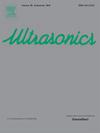Numerical and experimental study of echogenicity in 3D-printed tissue-mimicking materials
IF 3.8
2区 物理与天体物理
Q1 ACOUSTICS
引用次数: 0
Abstract
The main focus of this work is the echogenicity of a 3D-printed synthetic composite material that mimics the acoustic properties of cardiac biological tissues to provide ultrasound images similar to those obtained during interventional cardiology procedures. The 3D-printed material studied is a polymer-based composite with a matrix–inclusion microstructure, which plays a critical role in ultrasound response due to ultrasound-microstructure interaction at the involved medical echography wavelengths. Both numerical simulations and experimental observations are carried out to quantitatively establish the relationship between the 3D-printed microstructure and its ultrasonic echogenicity, considering different microstructure characteristics, namely area fraction and size of the inclusion, and its actual printed shape. A numerical evaluation based on finite element modeling is carried out to characterize the acoustic properties of the 3D-printed synthetic tissue: phase velocity, attenuation coefficient, and B-mode ultrasound images. Moreover, a morphological experimental study of the shape of the real 3D-printed inclusions is carried out. It shows a significant deviation of the final printed inclusions compared to the input spherical shape delivered to the 3D printer. By simulating and comparing numerically generated microstructures and 3D-printed real microstructures, it is shown that the actual shape of the inclusion is significant in the scattering of the ultrasonic wave and the echogenicity of the printed material.
3d打印仿组织材料回波性的数值与实验研究。
这项工作的主要重点是3d打印合成复合材料的回声性,该材料模仿心脏生物组织的声学特性,提供类似于在介入性心脏病学过程中获得的超声图像。所研究的3d打印材料是一种基于聚合物的复合材料,具有基体-夹杂微观结构,由于超声-微观结构在相关医学超声波长下的相互作用,在超声响应中起着关键作用。通过数值模拟和实验观察,定量建立3d打印微观结构与其超声回波性之间的关系,同时考虑不同的微观结构特征,即夹杂物的面积分数和尺寸,以及其实际打印形状。基于有限元建模的数值评估对3d打印合成组织的声学特性进行了表征:相速度、衰减系数和b型超声图像。此外,对真实3d打印夹杂物的形状进行了形态学实验研究。它显示了最终打印的内含物与交付给3D打印机的输入球形相比的显著偏差。通过对数值生成的微结构和3d打印的真实微结构进行模拟和比较,结果表明,夹杂物的实际形状对超声波的散射和打印材料的回波性有显著影响。
本文章由计算机程序翻译,如有差异,请以英文原文为准。
求助全文
约1分钟内获得全文
求助全文
来源期刊

Ultrasonics
医学-核医学
CiteScore
7.60
自引率
19.00%
发文量
186
审稿时长
3.9 months
期刊介绍:
Ultrasonics is the only internationally established journal which covers the entire field of ultrasound research and technology and all its many applications. Ultrasonics contains a variety of sections to keep readers fully informed and up-to-date on the whole spectrum of research and development throughout the world. Ultrasonics publishes papers of exceptional quality and of relevance to both academia and industry. Manuscripts in which ultrasonics is a central issue and not simply an incidental tool or minor issue, are welcomed.
As well as top quality original research papers and review articles by world renowned experts, Ultrasonics also regularly features short communications, a calendar of forthcoming events and special issues dedicated to topical subjects.
 求助内容:
求助内容: 应助结果提醒方式:
应助结果提醒方式:


